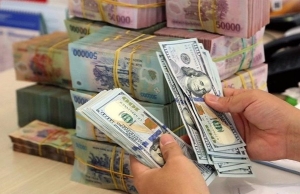Steady ship anticipated for monetary policy to 2025
 |
Based on the latest macroeconomic data from Vietnam and the US, can you provide some forecast scenarios for exchange rates, interest rates, and inflation in the second half of 2024?
For Vietnam, we expect the exchange rate to remain volatile, mainly due to the uncertainty of US Fed policy ahead. While the market has dialled down the possibility of Fed rate cuts in 2024, our current forecast is for two Fed rate cuts to take place in the second half of 2024.
Rate cuts will put some downward pressure on the US dollar and hence VND to appreciate. Currently, our forecast for the VND is to strengthen towards 24,800-25,000 per USD by the end of the year.
In Vietnam, we anticipate the interest rate policy to stay steady for now as the State Bank of Vietnam will proceed cautiously given the uncertain external environment. This is in part to fend off depreciation pressures on the VND and also in response to inflation pressures in Vietnam, with the CPI headline is inching towards the central bank’s target of 4.5 per cent (4.03 per cent on-year in first five months of 2024).
The main driver of Vietnam inflation in recent months has been food price increases which are likely to be due to global supply chain disruptions in the Red Sea area, as well as adverse weather/climate which impacted crop yields, just as domestic demand is on a recovery phase.
 |
Moving towards 2025, what factors do you expect to drive growth or recovery for the Vietnamese economy?
For Vietnam, exports and investment inflows, along with tourism and domestic consumption, will remain the key growth drivers in the next 6-12 months.
Recent statistics on trade, foreign direct investment (FDI) and tourism very much affirm such development. In the year to date, total exports and imports rose 22.6 per cent on-year to $305.53 billion, with both exports and imports rising double-digit on-year (15.2 per cent and 18.2 per cent respectively).
Foreign investing inflows came in at the highest in five years, at $8.3 billion in the first five months of 2024, reinforcing the view that companies remain confident of Vietnam remaining competitive and of future demand for their products.
Conversely, what risks should be monitored as potential black swan events for the global economy?
Geopolitical risks will continue a major unknown, particularly in the Middle East and also Eastern Europe, as shipping routes as essential commodities including oil, agricultural products among others are vulnerable to disruptions in those areas.
As such, countries and companies need to take pre-emptive risk management actions to counter these and other surprises, including hedging for exchange rate and other market volatilities, diversifying export markets and import sources to ensure minimal impact from disruptions in supply chains, and maintaining strong and close relations with neighbouring countries/markets to ensure stability and support.
Which sectors do you believe will show notable recovery in the second half of 2024 and early 2025, and why?
Manufacturing sectors and related exports goods will be the bright spots for Vietnam in the next 6-12 months. With the US economy staying resilient, demand will be supported.
The latest export data shows that demand for Vietnam’s exports continues to be optimistic, as seven main exports categories (electronics, computers, components, mobile phones, garments/textiles, footwear, and timber) accounted for 65 per cent of total export revenue in January to May 2024.
These will be areas of competitive advantage for the manufacturing and exports sector in Vietnam, and the momentum is expected to carry on through to 2025.
| Recovery momentum intact into second half of 2024 Vietnam started off 2024 with a robust economic performance, as reflected by the 5.66 per cent on-year growth in Q1. The most recent data released by the General Statistics Office (GSO) continued to reaffirm the encouraging outlook for Vietnam’s growth trajectory. The Purchasing Managers’ Index for the manufacturing sector rose for the second straight month in May, at 50.3, and the fourth positive reading in the first five months of 2024. This came after industrial production gained 8.9 per cent on-year in May, marking the third straight month of growth in 2024. Exports of goods recorded its third month of double-digit gain, rising 15.8 per cent on-year in May from 10.6 per cent in April, while imports rose 29.9 per cent on-year from 19.9 per cent in April. In the year-to-date (YTD), exports rose 16 per cent on-year and imports increased by 18.6 per cent in May, compared to the same period in 2023. The trade surplus amounted to $7.8 billion YTD in May, narrower than the $9.5 billion in the same period last year. YTD foreign direct investment rose 7.8 per cent on-year to $8.3 billion in May, the fastest in the 5-month period since 2018, following the record inflows of $23.2 billion in 2023. Domestic activities are on track, with total goods retail sales and consumer service revenues increasing by 8.7 per cent on-year YTD in May, underpinned by restaurants and accommodation (15 per cent on-year) and tourism (45 per cent). While external headwinds continue to weigh on economic prospects (including conflicts in Eastern Europe and the Middle East), Vietnam’s prospects are bolstered by the recovery in the semiconductor cycle, stable growth in China and the region, as well as the ongoing supply chain shifts. We expect GDP growth to reach 6 per cent on-year in Q2, extending the 5.66 per cent gain in Q1. We maintain our growth forecast for Vietnam at 6.0 per cent for 2024 (official target: 6.0-6.5 per cent).Source: UOB |
 | Monetary policy governance requires thorough consideration: official As the governance of the monetary policy has to concurrently guarantee multiple targets, including reducing interest rates, expanding credit, stabilising foreign exchange rates, and ensuring credit institutions’ safety, thorough consideration is needed before any steps are taken, Deputy Governor of the State Bank of Vietnam (SBV) Dao Minh Tu. |
 | PM chairs meeting on fiscal, monetary policy management Prime Minister Pham Minh Chinh chaired a meeting in Hanoi on May 16 with ministries and agencies to discuss the coordination of fiscal and monetary policies aimed at maintaining macroeconomic stability, controlling inflation and promoting growth. |
What the stars mean:
★ Poor ★ ★ Promising ★★★ Good ★★★★ Very good ★★★★★ Exceptional
Related Contents
Latest News
More News
- Main drivers for Vietnam’s digital economy future (December 03, 2025 | 11:35)
- Pivotal stage of growth paves way for rise in M&As (December 03, 2025 | 10:00)
- Positive projections for M&A interest from Thailand (December 03, 2025 | 09:40)
- Manifesting the first line of defence in cybersecurity (December 03, 2025 | 09:00)
- The transformational role AI can play in accounting arena (December 03, 2025 | 08:00)
- Unlocking 5G-AI potential in Singapore (December 03, 2025 | 08:00)
- Data-driven strategies vital for a fast-evolving nation (December 02, 2025 | 09:41)
- Policy to practice: how Vietnam can lead the region (November 26, 2025 | 16:03)
- Mobilising private capital at scale vital for climate battle (November 26, 2025 | 15:36)
- VILAF and Yoon & Yang launch Vietnam - Korea Practice Unit (November 26, 2025 | 15:16)

 Tag:
Tag:




















 Mobile Version
Mobile Version